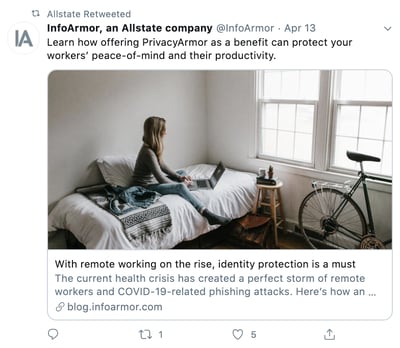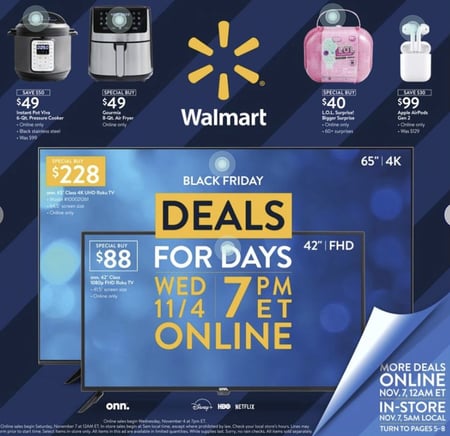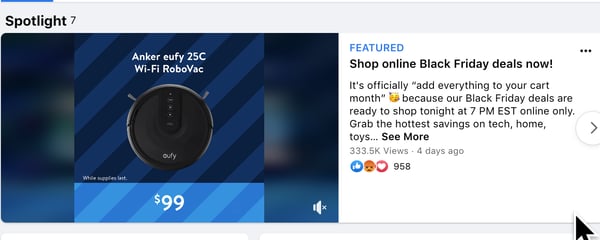According to the Bureau of Labor Statistics, inflation went up 8.2% between September 2021 and September 2022. As a result, experts theorized that this would take a toll on both retailers and shoppers.

Download Now: 2022 State of U.S. Consumer Trends Report
Shoppers would be looking for larger-than-normal discounts while retailers could struggle to offer them.
Below, we’ll highlight what we learned from polling 300+ consumers after this Black Friday. Then, we’ll share a few marketing tips on creating effective Black Friday ads.
What We Learned About Black Friday Shoppers & Brands in 2022
1. Inflation didn’t have the impact we expected.
The word everyone had on their mind in the weeks leading up to Black Friday was inflation. With inflation up over 7%, retailers feared consumer spending would be much lower than typical.
According to Retail Dive, brands like Target and ThredUp projected lower earnings for Q4.
Contrary to speculation, consumer spending did not see a sharp decrease this year. In fact, one Adobe Analytics report found that online spending was up 2.3% year-over-year.
One way consumers handled rising inflation is by using buy-now-pay-later services. According to a CNBC report, these transactions increased 78% compared to the week prior.
One thing’s for sure: Black Friday is no longer the long lines and midnight openings. Consumers believe they can get the same – or better – deals online and as such, visiting a store will require a different motivation.
For ecommerce brands, this is great news. For offline brands, this may require adopting a new approach that prioritizes an online-first strategy.
More on that in the next section.
2. Ecommerce brands are outperforming stores.
One Criteo survey suggests that Black Friday is becoming more like Cyber Monday, as consumers are conducting most of their transactions online.
The survey found that retailers’ websites saw a 9% year-over-year increase in the week leading up to Black Friday. In addition, consumers increased their online transactions by 4.8% globally.
Here’s another shocking figure: Online transactions for U.S. retailers increased over 374% month-over-month whereas in-store ones only increased by 64%. This suggests that online deals are more enticing to consumers.
Retailers in the EMEA region also saw similar trends, although the increases weren’t as high.
According to the Criteo study, a large reason for that is price. Consumers spend a lot of time online to find the best deals and they also believe they can find better prices this way versus in person.
We surveyed 325 U.S. consumers and when asked, “Did you go to a physical store on Black Friday after seeing an ad for its deals?” only 38.5% answered yes.
3. Social media was a top channel for Black Friday ad engagement.
It seems impossible to go through Black Friday without seeing at least one ad. When we ran this survey last year, respondents clicked on the ads they saw on social media the most.
This year, online ads (meaning on websites or search engines) took the #1 spot with 32.9% of respondents saying those are the Black Friday ads they clicked on. However, social media came close with 32%.
Social media can be a big revenue driver when it comes to Black Friday ads. And the opportunities it offers continue to expand.
Let’s take a look at Instagram for example. You can discover a brand, scroll through its profile, see a product you like, and complete a purchase without ever leaving the platform.
With so many social media platforms offering ecommerce features, brands can attract shoppers at any stage of the buyer’s journey and consumers can experience a seamless shopping experience. It’s a win-win.
From an advertising perspective, it’s important that brands strategize and launch their campaigns early.
According to Nerd Wallet, brands like Target and Amazon started their Black Friday campaigns as early as Oct. 6 this year.
This is in response to a recent consumer trend where shoppers start their holiday shopping earlier than in previous years. As a result, brands are launching early to ensure potential consumers are seeing which promotions they have to offer.
So, instead of waiting for the week leading up to Black Friday, when timelines are already flooded with ads, consider starting a few weeks before and you may get better results.
5 Tips for Creating Effective Black Friday Ads
1. Plan (and launch) early.
This year, consumers started holiday shopping early.
We can’t predict with full accuracy what things will look like next year. So, in absence of knowledge, it’s better to stay ready so you don’t have to get ready.
In other words, don’t start planning your promotion strategy in early November. You want to give your team enough time to plan an effective strategy that will reach your target audience at the right place and at the right time.
You’ll need enough time to craft a plan, develop the strategy, build the creative assets, and launch the campaign. You’ll also need to account for any obstacles you may encounter along the way.
2. Highlight how a service or product can solve for your customer.
Your ads should aim to educate ideal customers about your offerings, how they can help them, or why they might need them in their daily lives.
But, how do you convey that your offerings are valuable, important, or necessities when you don’t actually sell an essential product? Although it can take some creativity, it is possible to do this.

Above is an example of Twitter content from InfoArmor, an information security service owned by Allstate.
In the tweet, InfoArmor shared a blog post about the dangers of information security when working remotely and how InfoArmor could protect remote employee information.
3. Diversify your promotion channels.
We mentioned that social media is a huge revenue generator during Black Friday.
However, that doesn’t mean it’s the only channel you should leverage to attract shoppers. In fact, you should promote your ads across all channels to maximize your reach.
Have a newsletter? Share your offers there. You could also consider running a Google Ads campaign.
Regardless of which online platforms you embrace, be sure to create content that speaks to those customers, rather than just placing a basic ad on every website you can access.
By creating content that’s tailored to the platforms your customers use, you’ll increase the likelihood of catching their eyes as they scroll through endless web pages, feeds, or email inboxes. And, once you grab their attention, you can use that content to highlight your value proposition in an entertaining or interesting way.
For example, if you’re creating an ad for Instagram, it might be tempting to just use a picture of the ad you made for a website or newspaper on with a basic caption.
But, that might not be engaging for people scrolling through their feeds looking for valuable product information or entertaining content. Instead, consider creating a short marketing video or a series of photos of customers with your product to better engage this audience.
Below is a great example of a Black Friday post that could also work well as an ad on Instagram. The post shows a video demo of someone from Hair Vivi putting on one of the brand’s wigs.
While the video shows viewers how easy it is to put on the wig, the caption also highlights the product’s value and the company’s Black Friday deals.
4. Present deals, sales, or affordable offers.
Budget-conscious shoppers will be looking for the best deals this holiday season. If you can offer a deal or sale on your product or offering, highlight that information in your advertising.
Here’s a great ad from Walmart that highlights all the online deals they’ll be offering this year:

Along with the ad highlighting a bunch of great deals and alternatives for Black Friday in-person sales, the ad is also interesting because it’s interactive online but formatted so it can also work as a static print ad if needed.
Aside from the ad above, Walmart has created content with a similar aesthetic and deal-oriented message for social media platforms like Facebook. Here’s a screenshot of featured content on its Facebook Business page.

5. Embrace video marketing.
If you think video marketing is only for big brands, think again.
In our 2022 State of Marketing Report, we found that video is the leading form of marketing content used across industries. And, with Gen-Z and millennials embracing video more than ever for product discovery, this format becomes more of a low-hanging fruit each year.
In the last year, we’ve seen all sorts of small and large brands affordably embrace video to attract and nurture leads.
Every Black Friday is an opportunity to learn more about your target audience. Pay attention to what works and what doesn’t, and look out for trends that will help you improve your ad strategy.